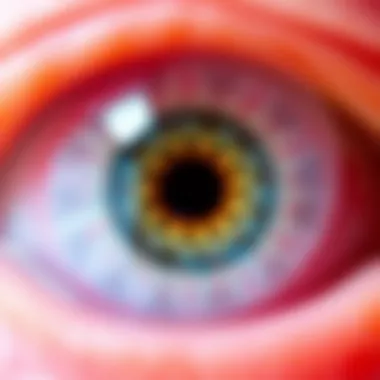Psoriatic Uveitis: Effective Treatment Approaches


Intro
Psoriatic uveitis represents one of the more intricate challenges faced within the realm of ophthalmic disorders. This condition is not just a mere inflammation of the eye; it intertwines with the systemic implications of psoriasis, amplifying both the physical and emotional burdens on individuals who are affected. Navigating the treatment landscape for psoriatic uveitis requires a nuanced understanding of its etiology, a flare for strategic medical interventions, and a compassionate approach toward patient management.
From the puzzling interactions between immune responses to the multifaceted treatment strategies available today, there remains much to uncover. The treatment of psoriatic uveitis is not a linear path. Instead, it reflects an evolving spectrum of methodologies including biologic agents, corticosteroids, and non-steroidal anti-inflammatory drugs. Moreover, it cannot be overlooked that effective management of this condition also includes a multidisciplinary approach that recognizes the psychological implications of living with such a chronic ailment.
In this article, we unpack these various dimensions – from the historical context that frames our understanding of psoriatic uveitis to the cutting-edge findings that shape contemporary treatment strategies. By doing so, we aim to provide an engaging and informative exploration for students, researchers, educators, and professionals in the field.
Understanding Psoriatic Uveitis
Psoriatic uveitis is not merely a side effect of psoriasis; it is a significant complication that requires careful attention and management. Understanding this condition is crucial because it affects a sizable subset of individuals living with psoriasis, potentially leading to serious ocular complications if left untreated. Recognizing psoriatic uveitis means acknowledging both its implications on vision and the overall quality of life for patients.
Defining Psoriatic Uveitis
Psoriatic uveitis refers specifically to the inflammation of the uveal tract in individuals who have psoriasis. The uveal tract consists of the iris, ciliary body, and choroid, layers rich in blood vessels that play vital roles in eye health and vision. The inflammation can manifest as an acute episode but may also become a chronic issue, thus demanding a nuanced approach to treatment. Patients may experience a range of symptoms including blurred vision, sensitivity to light, and redness of the eye, all stemming from this inflammation.
Defining psoriatic uveitis helps in laying the groundwork for patient education and necessary treatment options. This understanding is foundational, stressing that addressing it properly can mitigate broader complications such as glaucoma or even retinal detachment.
Epidemiology and Demographics
Epidemiological studies indicate that psoriatic uveitis occurs in about 7-30% of patients with psoriasis. The variance in figures is due in part to differing diagnostic criteria and populations surveyed. Most notably, this ocular condition often appears in younger adults aged 20 to 50 years, affecting both genders comparably, although some studies suggest a slight male predominance.
Additionally, there is a strong correlation between the severity of skin psoriasis and the risk of developing uveitis. Patients with more severe skin manifestations, characterized by extensive plaques and arthritic involvement, have higher incidences of uveal inflammation, illustrating that psoriatic uveitis must be part of holistic patient evaluations.
The social and ethnic factors also play a role in psoriatic uveitis prevalence. For instance, some research indicates that certain groups, like the Caucasian population, are more affected compared to others, which suggests a genetic predisposition that requires further investigation.
Pathophysiological Mechanisms
Delving into the pathophysiological mechanisms behind psoriatic uveitis unveils the interplay between immune response and inflammation. It is thought that psoriatic uveitis arises from the activation of T cells, akin to the influences seen in skin psoriasis. The immune dysregulation leads to an inflammatory response that targets not only the skin but also the ocular structures.
Key cytokines such as tumor necrosis factor-alpha (TNF-alpha) and interleukin-17 (IL-17) become upregulated, promoting the inflammatory processes within the eye. This dysregulation can result in not just uveitis but also enthesitis and chronic arthritis, highlighting the systemic nature of the psoriatic disease process. Clinicians note that appreciating these mechanisms aids in making informed treatment decisions, as targeting specific inflammatory pathways may mitigate both skin and ocular manifestations.
Understanding the interplay of inflammation and immune response is vital in managing psoriatic uveitis, helping clinicians to tailor therapies effectively.
In summary, a comprehensive understanding of psoriatic uveitis encompasses its definition, epidemiological data, and underlying biological mechanisms. This in-depth grasp is indispensable for healthcare providers, researchers, and patients, enhancing the overall approach to treatment and management of this complex condition.
Clinical Presentation
The clinical presentation of psoriatic uveitis is critical to understanding the management of this condition. Recognizing the symptoms early can significantly affect outcomes for patients. Individuals may experience a range of ocular symptoms that overlap with systemic manifestations of psoriasis. Given its association with skin psoriasis, the clinical approach should reflect an awareness of these intertwined conditions. Understanding how psoriatic uveitis manifests is paramount for accurate diagnosis and effective treatment strategies.
Symptoms and Diagnosis
Patients suffering from psoriatic uveitis often present with a variety of symptoms. These can include:
- Photophobia (sensitivity to light)
- Blurred vision
- Eye redness
- Increased tear production
- Pain or discomfort around the eye
The combination of these symptoms often leads to a sense of urgency, pushing individuals to seek ophthalmologic care. Diagnosing psoriatic uveitis involves a thorough examination, including:
- Visual acuity tests to assess vision clarity
- Slit-lamp examination to evaluate the anterior segment of the eye
- Fundoscopic examination for viewing the retina
Additionally, a comprehensive assessment of medical history, particularly regarding psoriasis, is vital. The ophthalmologist may also explore laboratory tests and imaging if necessary, making this phase essential for tailoring appropriate treatment. The early detection of symptoms may help avert possible vision loss, which underscores the importance of awareness of these clinical signs.


Differential Diagnosis
Differentiating psoriatic uveitis from other types of uveitis is crucial for effective treatment. Various conditions might mimic the symptoms associated with psoriatic uveitis, such as:
- Ankylosing spondylitis-associated uveitis
- Sarcoid uveitis
- Herpetic uveitis
- Idiopathic uveitis
Physicians must consider these alternatives by evaluating the history and clinical findings. It can be a perplexing puzzle, as each uveitis variant has its own unique traits and treatment paths. If misdiagnosed, it can lead to inappropriate management, potentially worsening the patient’s condition.
Treatment Modalities
The approach to treating psoriatic uveitis requires careful consideration due to the interplay between ocular health and systemic management of psoriasis. This section explores various treatment modalities aimed at addressing the complexities of psoriatic uveitis. Each strategy has distinct benefits and considerations, making it crucial for healthcare providers to tailor their approach according to individual patient needs.
Pharmacological Approaches
Pharmacological management remains the mainstay for many patients. Disease-modifying antirheumatic drugs (DMARDs) and immunosuppressants play a pivotal role in reducing inflammation in uveitic conditions. Methotrexate is frequently employed; it has shown effectiveness in controlling both psoriasis and uveitis for many individuals. However, routine monitoring is imperative to detect potential side effects, such as liver toxicity.
Other options like sulfasalazine and cyclosporine are used as well but are less common. The choice of medication often hinges on the severity of the disease and any comorbid conditions. In summary, pharmacological therapies not only help mitigate inflammation but can also improve the quality of life by preventing visual complications.
Biologic Therapies
Biologic therapies have revolutionized the treatment landscape for patients with psoriatic uveitis. These targeted therapies, such as adalimumab and ustekinumab, specifically inhibit pathways involved in the inflammatory process. For instance, adalimumab works by blocking TNF-alpha, a crucial factor in the inflammatory cascade.
The efficacy of biologics often leads to rapid improvement in both ocular and skin symptoms, making them a preferred choice for many clinicians. However, the high cost and the need for consistent follow-ups can be a hurdle. Furthermore, health professionals must remain vigilant regarding potential side effects, such as increased risk of infections. The emergence and continuous development of these therapies hold promise for more tailored treatment protocols in the future.
Corticosteroids and NSAIDs
As a cornerstone of treatment, corticosteroids are utilized for their potent anti-inflammatory properties. In cases of acute flair-ups, topically administered corticosteroids may be the first line of defense. Systemic administration can also be considered for more severe presentations. While effectively reducing inflammation and preventing vision loss, there’s a delicate balance in the duration of use to mitigate the risk of complications such as cataracts or glaucoma.
Non-steroidal anti-inflammatory drugs (NSAIDs) offer additional relief by alleviating pain and inflammation. Though they are generally prescribed as adjunctive therapies, their role should not be underestimated in providing symptomatic relief. These medications are often well-tolerated, and their use can significantly enhance the patient’s comfort and mobility. However, it is essential to monitor for gastrointestinal side effects, especially with long-term usage.
Surgical Interventions
Surgical interventions are considered when pharmacological and non-surgical approaches fail to yield significant improvements or in cases of structural eye damage. Procedures such as pars plana vitrectomy can be employed to remove inflammatory debris or control retinal complications. While these interventions are less common, they can be life-changing for individuals experiencing severe vision threats due to uveitis.
However, surgical options come with inherent risks, including infection and bleeding, so careful patient selection is paramount. Discussions around surgical interventions should be grounded in a thorough assessment of risks versus potential benefits, aligning with the patient’s overall treatment goals.
Multidisciplinary Care Approach
An effective management strategy for psoriatic uveitis mandates a multidisciplinary care approach. This method integrates various medical specialties to tackle the complexity of the disease. It ensures that all facets of a patient's health are assessed and addressed, ultimately optimizing treatment outcomes.
Each specialist brings unique expertise to the table, allowing for a more holistic view of the patient's condition. The collaboration between rheumatologists, ophthalmologists, and dermatologists is particularly essential as they align their insights to promote a coordinated treatment plan.
Role of Rheumatology
Rheumatology plays a pivotal role in managing psoriatic uveitis, given its tight association with psoriatic arthritis. Rheumatologists focus on controlling psoriasis flare-ups, which can significantly influence the severity of uveitis. By prescribing disease-modifying antirheumatic drugs (DMARDs) or biologics specifically aimed at mitigating psoriasis, they can indirectly reduce ocular inflammation.
In addition, rheumatologists monitor joint health, as psoriatic uveitis often coexists with joint manifestations. Regular consultations between the rheumatologist and patient are necessary to evaluate treatment effectiveness and side effects, ideally leading to timely adjustments in therapy. This interconnection facilitates a comprehensive approach that can enhance patient well-being.
Collaboration with Ophthalmology
The involvement of ophthalmologists is vital in the management of psoriatic uveitis due to their specialized knowledge in ocular health. They are responsible for performing comprehensive eye examinations to identify early signs of inflammation or other ocular complications. A significant aspect of their role is prescribing topical and systemic therapies aimed at resolving uveitis.


Ophthalmologists also play a key role in assessing patients' vision changes and potential complications such as cataracts or glaucoma. They work in tandem with rheumatologists to provide a seamless experience for the patient, facilitating communication regarding treatment adjustments based on ocular response.
"A cohesive approach that includes both ocular and systemic evaluation is pivotal in mitigating the effects of psoriatic uveitis on patients' daily lives."
Impact of Dermatology in Management
Dermatologists contribute significantly to the management of psoriatic uveitis through their expertise in skin care. They are tasked with managing psoriasis - the skin manifestations underlying the uveitis. As skin symptoms often affect patient life quality, prompt and effective dermatological treatments can reduce disease burden.
Moreover, dermatologists can help educate patients about the systemic nature of psoriasis and its ocular implications, promoting awareness and adherence to recommended therapies. Their ongoing involvement can help prevent exacerbations and maintain skin health, further impacting overall treatment success.
In summary, a multidisciplinary care approach consolidates the strengths of rheumatologists, ophthalmologists, and dermatologists to foster a unified response to psoriatic uveitis. This teamwork not only helps in mitigating the condition but also positions patients towards a healthier long-term outcome.
Challenges in Treatment
Psoriatic uveitis presents a daunting set of challenges in its treatment, making it crucial to understand the various dimensions involved. Considering the psychological, social, and medical implications, the treatment requires a multifaceted approach aimed at improving patient outcomes and quality of life. This section dives into key areas affecting treatment strategies, emphasizing the need for comprehensive care.
Managing Chronicity
The chronic nature of psoriatic uveitis magnifies the hurdles in effective treatment. Continuous inflammation can lead to irreversible ocular damage if left unchecked. This underscores the importance of long-term management strategies, which can often be tedious and require close monitoring. Keeping the inflammation at bay is not just about managing symptoms; it’s about avoiding the havoc it can wreak upon the patient’s vision. Regular follow-ups and consistent communication between healthcare providers and patients play vital roles here.
- Tailored Treatment Plans: Each individual's course of psoriatic uveitis can vary widely, carrying different symptom severities. A personalized treatment plan that factors in individual medical history, concurrent conditions, and potential medication interactions can be more effective.
- Education and Empowerment: Educating patients on recognizing the flare-ups and understanding treatment regimens can bolster their participation in their care. Empowered patients often help mitigate the chronicity of their condition by adhering to proposed strategies.
Adverse Effects of Treatments
Every treatment method carries its own set of risks, and psoriatic uveitis is no exception. Adverse effects can often lead to discontinuation of therapies that might otherwise help. Biologics, corticosteroids, and immunosuppressants may occasionally offer relief, but can also create additional problems.
- Common Side Effects: These treatments can lead to an array of side effects such as increased susceptibility to infection, gastrointestinal issues, and fatigue. Even simple medications can sometimes cause unexpected reactions.
- Long-Term Risks: A careful assessment of the risk versus reward must be made. Long-term use of corticosteroids, for instance, might lead to osteoporosis or other systemic complications. This necessitates a balancing act between managing the uveitis effectively while safeguarding overall health.
Patient Adherence and Compliance
One of the most pressing challenges is ensuring patient adherence to treatment protocols. This involves not only prescribing the necessary medications but also supporting the patients in their journey towards managing a chronic condition. Non-compliance can stem from various factors:
- Complex Regimens: A complex medication schedule may overwhelm patients, leading to missed doses and ineffective treatment. Simplifying regimens wherever possible may enhance adherence.
- Perceived Efficacy: Patients may sometimes feel disillusioned if they do not see immediate results. Health care providers must set realistic expectations and provide encouragement.
- Support Systems: Building a robust support network, involving family and peers can also help. Psychological counseling or support groups may provide emotional backing, bridging the gap between the patient and their care plan.
Adherence to treatment in chronic conditions like psoriatic uveitis remains a dynamic challenge, often requiring a blend of medical, social, and psychological strategies.
Quality of Life Considerations
The significance of quality of life in the context of psoriatic uveitis cannot be overstated. Patients grappling with this condition not only face physical challenges but also navigate numerous psychological and social obstacles that profoundly affect their day-to-day existence. Understanding these facets can help healthcare professionals tailor management strategies that not only target the illness itself but also enhance the overall well-being of individuals affected by psoriatic uveitis.
One of the major elements impacting quality of life is the psychological impact of living with chronic conditions such as psoriatic uveitis. The gradual onset of symptoms and the uncertainty that accompanies chronic uveitis may lead to feelings of anxiety and depression. This often affects how patients view themselves and their interactions with others. The chronic nature of the disease and the possibility of vision impairment may compound feelings of helplessness. Therefore, recognizing these emotional challenges is a crucial part of a holistic approach to treatment.
Psychological Impact
Research indicates that individuals with psoriatic uveitis may experience a higher prevalence of anxiety and depression compared to the general population. This emotional turmoil often stems from a lack of understanding of the condition, fears of vision loss, and the long-term implications of living with a chronic disease.
- Fear and Uncertainty: The worry that symptoms may flare up at any time can create a cycle of anxiety, which might discourage patients from fully engaging in daily activities.
- Social Withdrawal: Many individuals choose to isolate due to concerns about their appearance, especially when psoriasis manifests visibly on the skin or eyelids. This social withdrawal can exacerbate feelings of loneliness and depression.
- Coping Mechanisms: It's important to offer support strategies, such as counseling, that provide patients a safe space to express their feelings. Mindfulness practices or peer support groups can also play a valuable role.
Fostering open communication about mental health can promote better overall outcomes for patients dealing with psoriatic uveitis. Integrating mental health evaluations into routine care may facilitate early interventions and improve treatment adherence.
Social and Economic Factors


When considering quality of life, social and economic factors come into play prominently. Many patients make modifications to their lifestyle due to the limitations brought on by psoriatic uveitis. These changes can result in both economic burdens and social implications that further strain their overall quality of life.
- Employment Challenges: Patients may struggle to maintain consistent work in professions requiring visual acuity or those that exacerbate their symptoms. Moreover, extended absences from work due to flare-ups can lead to financial strain, affecting their sense of stability.
- Healthcare Costs: The expenses associated with treatment can mount up quickly due to frequent visits to healthcare providers, the need for medications, and various therapies. This financial burden can contribute to stress, which feeds back into mental health issues.
- Social Support Systems: Support from friends and family is essential, yet it can sometimes feel inadequate as loved ones may not fully understand the complexities of living with psoriatic uveitis. Educational initiatives about the condition can help bridge this gap.
"Understanding the multifaceted impacts of psoriatic uveitis on quality of life is not just beneficial for the patients, but can transform how we as a society view chronic diseases."
Addressing these factors holistically can lead to more tailored interventions, better support networks, and an overall improvement in the daily lives of those living with psoriatic uveitis.
For further insights into mental health and chronic illnesses, visit National Institute of Mental Health (NIMH). Those interested in how chronic conditions can affect social interactions will find valuable information on Chronic Illness Alliance.
Future Directions in Research
The landscape of psoriatic uveitis treatment is evolving. As our understanding of this condition progresses, emerging research avenues hold the potential to enhance treatment effectiveness and patient outcomes. Awareness of these future directions is imperative, given their relevance to improving therapeutic strategies and overall management.
Emerging Treatment Strategies
Emerging treatment methods are a beacon of hope for patients and healthcare professionals alike. Novel therapeutic agents are being developed to specifically target the inflammatory processes associated with psoriatic uveitis. For instance, recent studies are focusing on JAK inhibitors, which show promise in modulating immune responses effectively.
- Targeted therapies: The shift towards precision medicine is notable. By identifying genetic markers and specific pathways involved in the pathophysiology of psoriatic uveitis, researchers can tailor treatments to individual patient profiles. This personalized approach may lead to higher efficacy with fewer side effects.
- Combination therapies: Utilizing a mix of treatment strategies can bring greater success. For example, integrating biologic therapies with conventional medications like corticosteroids might not only enhance treatment outcomes but also help in tapering down corticosteroid use, minimizing their potential adverse effects.
- Clinical trials: Ongoing clinical trials aim to explore the safety and efficacy of these novel therapies. It's crucial for future advancements that patients participate in such research, contributing to a broader understanding of how these therapies can be optimized.
As researchers continue to explore these innovative avenues, the landscape of psoriatic uveitis treatment may transform, offering more promising avenues for patients.
Novel Biomarkers for Assessment
Biomarkers play a pivotal role in the evolution of psoriatic uveitis management. They offer critical insights into disease activity and treatment response, aiding in the customization of therapeutic regimens.
- Inflammatory markers: The identification of specific inflammatory cytokines and proteins could pave the way for timely interventions. For instance, elevated levels of Interleukin-17 have been linked to heightened disease activity in psoriatic uveitis, enabling clinicians to adjust treatment modalities more swiftly.
- Predictive markers: Aside from prognostic indicators, novel biomarkers could help predict patient responses to specific treatments. Understanding which patients are more likely to respond to biologics based on their biomarker profiles will optimize treatment selections, reducing the trial-and-error phase currently faced by many.
- Monitoring progression: Continuous assessment through biomarkers can lead to more dynamic management strategies. Regularly tracking these markers helps in evaluating treatment effectiveness and making necessary adjustments proactively.
In summary, the focus on novel biomarkers is an exciting aspect of psoriatic uveitis research. Update on these elements can significantly contribute to achieving better disease control and improving patients’ quality of life.
"The consideration of biomarkers not only leads to enhanced understanding but also transforms patient care in an impactful way."
As we move forward, the intricate pathways linking psoriatic uveitis and potential biomarkers represent a frontier yet to be fully explored. The integration of these discoveries in clinical practice holds tremendous promise for the future.
Culmination
Psoriatic uveitis presents a significant challenge in clinical practice, intertwining both the ocular and systemic implications of psoriasis. This article has scrutinized various treatment strategies pivotal to managing this condition, focusing on not just the biological mechanisms, but also the comprehensive approach that is essential for optimal outcomes.
Summarizing Key Points
In summary, addressing psoriatic uveitis requires a multifaceted treatment plan. Here are the crucial takeaways from our exploration:
- Comorbidities Matter: Psoriatic uveitis is often accompanied by other conditions. It's crucial to manage the whole patient, not just the eye symptoms.
- Medical Options are Varied: From corticosteroids to biologic therapies, the options are many, requiring an individualized approach to treatment based on a patient’s specific situation and response to medications.
- Team Effort: A multidisciplinary care approach ensures that all aspects of the patient’s health are addressed. Rheumatologists, ophthalmologists, and dermatologists must work together in harmony for the best results.
- Future Insights: Ongoing research into emerging treatment modalities and novel biomarkers holds promise for improving care and outcomes for patients.
- Quality of Life Considerations: Understanding and addressing the psychological and social factors impacting patients living with psoriatic uveitis is crucial. These elements directly influence patient adherence and overall health challenges.
Why References Matter
- Credibility: References validate the information shared. In the realm of health, where misinformation can lead to adverse outcomes, relying on peer-reviewed journals and reputable sources strengthens the trustworthiness of the article.
- Depth of Research: With references, readers can delve deeper into complex topics. For those interested in exploring specific treatment strategies or the underlying science, citations create pathways to further understanding.
- Educational Value: Well-referenced articles can serve as educational tools, guiding students, researchers, and healthcare professionals toward authoritative resources in the field of psoriatic uveitis and its treatment options.
Effective Referencing Strategies
- Utilize a mix of literature, including primary studies, review articles, and meta-analyses. This approach can provide a comprehensive view of the subject matter.
- Where possible, focus on the latest research. As medical science is a constantly evolving field, the most current studies often contain the most relevant findings.
- Incorporate government and educational resources, like those found on *gov and *edu domains, which typically offer trustworthy information and statistics.
“Reliable references are not just footnotes; they are the stepping stones for the reader's journey through complex medical information.”
For additional insights into related research, consider visiting:
- National Institute of Health
- Mayo Clinic
- American Academy of Ophthalmology
- PubMed
- National Psoriasis Foundation







